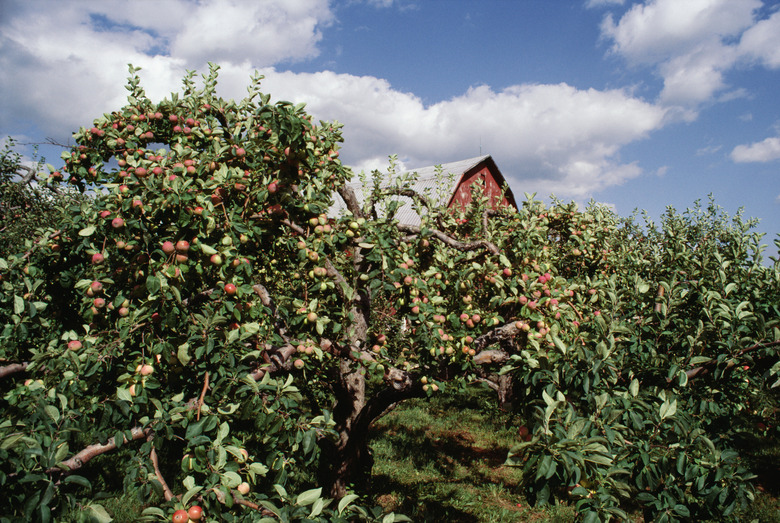How To Kill A Fruit Tree & Its Roots
It may seem baffling that anyone would consider killing a fruit tree when fresh, free fruit for your family is at arm's reach, but there's really no point in keeping a tree if it doesn't serve its purpose. Trees can stop producing good quality fruit over time, some trees never produce fruit at all and sometimes, having a large tree in the yard is more nuisance than the short harvest season is worth. However, fruit trees produce root suckers when cut down, so you must kill the entire root system to keep the tree from returning.
Step 1
Step 1
Prepare a solution of approximately 20 percent systemic herbicide, such as glyphosate or triclopyr, in a small, disposable bowl. Follow the label for specific mixing instructions, which vary among different brands and concentrations. If the glyphosate-based product contains 41 percent glyphosate, mix equal parts glyphosate and water in the bowl. You only need a small amount, so mix 1 cup of herbicide with 1 cup of water to avoid waste.
- It may seem baffling that anyone would consider killing a fruit tree when fresh, free fruit for your family is at arm's reach, but there's really no point in keeping a tree if it doesn't serve its purpose.
- However, fruit trees produce root suckers when cut down, so you must kill the entire root system to keep the tree from returning.
Step 2
Step 2
Cut down the fruit tree to within 4 to 6 inches of the ground, leaving only the stump in place. Use lopping shears and a pruning saw to remove the limbs before cutting the trunk, particularly if the falling tree's branches could damage surrounding trees.
Step 3
Step 3
Drill a few one-half-inch diameter holes straight down into the stump, if it measures greater than 6 inches in diameter. While optional, these holes act as reservoirs to hold herbicide so you can kill the roots faster. Space the holes evenly around the trunk, positioned close to the outer edge, so the herbicide is concentrated near the cambium layer. The cambium layer is the vascular transport system, located between the bark and internal wood layers, that is responsible for carrying water and carbohydrates through the trunk and to the roots.
Step 4
Step 4
Paint the exposed cut on the stump with the herbicide solution, using a cheap, disposable paintbrush. Paint the entire surface, but focus the application around the edge. Apply the herbicide as soon as possible or no later than four hours after cutting the tree, because the wood callouses and makes it difficult for the herbicide to penetrate. This is why it's important to mix the herbicide solution before cutting the tree.
- Cut down the fruit tree to within 4 to 6 inches of the ground, leaving only the stump in place.
- Space the holes evenly around the trunk, positioned close to the outer edge, so the herbicide is concentrated near the cambium layer.
Step 5
Step 5
Pour the remaining herbicide into the drilled reservoir holes, if applicable. If you still have some solution after filling the holes, wait an hour or two for the herbicide to absorb into the wood and refill the holes.
Step 6
Step 6
Monitor the stump frequently for new sucker growth over the next year, particularly for the first few months after treatment. As new suckers reach about 3 feet tall, cut the tips at an angle, bend them over and push them into a jug containing glyphosate or triclopyr herbicide for two days. Remove the tips from the jug and cut the sucker off at the ground. You might not have any sucker growth after the initial cut stump treatment.
Tip
This method works with all fruit trees, whether you want to kill a navel orange tree (Citrus sinensis) or an apple tree (Malus domestica). Orange trees are cold sensitive and only grow in U.S. Department of Agriculture plant hardiness zones 9 through 11. Apples are more cold hardy and grow in USDA zones 5 through 9.
Tip
After the roots and stumps die, they decay naturally in the soil. The easiest way to deal with the stump is to simply leave it untouched to die on its own, covering it with a mound of mulch so you don't trip over it. You can drill several holes in the stump and fill it with stump remover product or high-nitrogen fertilizer to speed up the decay process. If you want it gone immediately, dig out around the roots and pull it out of the ground.
Warning
If you have a very large fruit tree, hire a professional to cut down the tree so you can avoid damage to surrounding structures.
Warning
Avoid using a spray bottle to apply herbicides, especially around other fruit trees, because over-spray can severely damage or kill surrounding vegetation.
Things Needed
- Disposable bowl
- Glyphosate or triclopyr herbicide
- Lopping shears
- Pruning saw
- Hand saw or power saw
- Power drill (optional)
- 1/2-inch drill bit (optional)
- Disposable paintbrush
References
- Southern Living: Bradford Pears Must Die
- University of Illinois Extension: Why Fruit Trees Die
- The Ohio State University Extension: Controlling Undesirable Trees, Shrubs, and Vines in Your Woodland
- University of Minnesota Extension: Removing Trees and Shrubs
- University of California IPM Online: Woody Weed Invaders
